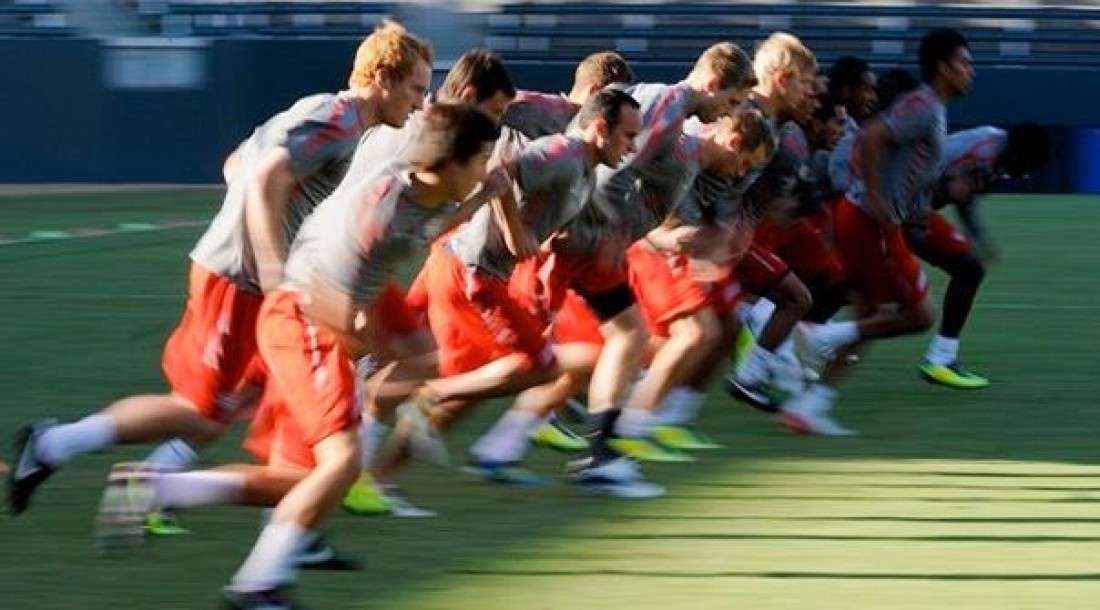Written by Soccer Fitness Internship Student Celia Palombella. Edited by Richard Bucciarelli

Every athlete knows the importance of training specifically to the type of sport they play. The question is, which forms of training are optimal towards each sport, and why? Soccer is a sport that relies heavily on a combination of various energy systems, due to the nature of the sport. These components include: speed, agility, aerobic/anaerobic endurance, strength, power, and skill; utilizing all three energy systems (ATP-PC, Glycolitic/Lactic acid and Aerobic) (Baker, 2013). Aerobic fitness is a very important aspect to focus on when training for soccer players, with anaerobic fitness and agility trailing closely behind. Aerobic fitness is geared towards soccer players in the sense that they need to be able to sustain high intensities throughout the total 90 minutes of the game. Many different types of aerobic fitness training tests have been used towards prescribing intensities for soccer players during their training sessions. Some of these tests include the Yo-Yo test, the 30-15 intermittent fitness test, VO2max test, and various types of shuttle tests.
Sport-specific tests are tests that are used to mimic the nature of the sport. These field tests are often used to evaluate the effects that training has on their athletes, along with methods based on heart rate and rate of perceived exertion to establish the specific internal load needed when training. Modes of aerobic training have been proven to be an important component of physical training for soccer athletes. Studies have verified this showing correlation between athletes’ aerobic power (VO2max) and where they rank on a competitive level, as well as between their quality of play and how much distance they cover during a game. Aerobic training can enhance soccer performances including distance covered, time spent at high intensities and number of sprints and ball possessions during a match (Helgerud, Engen, Wisloff &Hoff, 2001). Training at high aerobic intensities has also shown to improve recovery during high intensity exercise, which is the typical type of performance and training a soccer player would undergo.
In terms of laboratory assessments, VO2max tests and blood lactate levels can be used to assess the condition of a soccer player when prescribing intensities for training. VO2max and lactate thresholds are considered accurate measures of aerobic power and capacity. Assessing these variables with the appropriate protocols when training, could provide coaches with useful information about the effect on the athlete’s central and peripheral factors (Impellizzeri, Rampinini, & Marcora, 2005). However, since most laboratory assessments, such as VO2max are difficult to administer due to equipment cost and time taken to perform them, field tests have grown more popular for coaches to be used towards their soccer training protocols specific to aerobic training. The 20-m shuttle run test can be used to correlate the maximal running speed reached at the end of the test with athletes VO2max (Impellizzeri, Rampinini, & Marcora, 2005). Equations have been made for field tests like this one to estimate one’s VO2max as an alternative to performing a full on VO2max laboratory test.
The 30-15 Intermittent Fitness Test was invented by Martin Buchheit. It measures the maximal running speed that can be used towards prescribing training prescriptions for athletes. This test consists of 30-second shuttle runs with 15-second passive recovery periods. When the test ends, the running velocity from the last stage completed is used as the maximal running speed or velocity. A calculation is done with the results to determine the player’s individual maximal oxygen consumption (VO2max) (Footballscience.net, 2015). These results can be utilized when prescribing training intensities for athletes since each value is individualized to the athlete performing the test.
The Yo-Yo test is another form of an aerobic fitness test that is used by many soccer /strength and conditioning coaches for their athletes. It evaluates each player’s ability to repeatedly perform intense exercise. The results of the Yo-Yo test correlate with the high-intensity running distance that occurs in soccer games (Haugen & Seiler, 2015). The results can also be considered more valuable than measures done for maximal aerobic power. The Yo-Yo aerobic field test is set up as a 20-m long run with a 5-m 5-10 second recovery break in between. Each run is signalled to start from a beep, with beeps increasing times per each level. If the player does not make it to the opposite side before the second beep, the test is completed (Footballscience.net, 2015). Again, calculations for VO2max are done with a specific equation created for the Yo-Yo test.
Having an athlete’s VO2max results is very beneficial for coaches or trainers to know how to properly prescribe loads for athlete’s on an individual basis. For example, knowing the VO2max of one athlete can be incorporated into a training program using 75% of the athletes VO2max for a specific exercise intensity or load for a workout. Aerobic endurance levels of athletes can be tested in both laboratory and field settings. For players to be successful, aerobic and anaerobic capabilities must be at a certain level. Performance in soccer relies heavily on an athlete’s aerobic endurance. A study showed that individuals function at about an average of 70% of their VO2max, 80-90% of their HRmax, and blood lactate levels of 2-10 mmol/l, while covering a distance of 8-12km during a professional match (Footballscience.net, 2015). These results can be obtained through sport specific laboratory and field tests, such as the ones previously mentioned, to prescribe proper training intensities for athletes. The importance of an athlete’s aerobic system can also be seen when viewing the rankings for competitive teams. We now can form a conclusion around the importance of aerobic tests for soccer athletes specific to training.


Leave A Comment